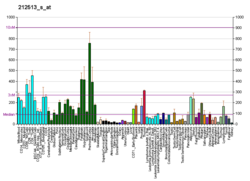| USP33 |
|---|
 |
| Available structures |
|---|
| PDB | Ortholog search: PDBe RCSB |
|---|
|
|
| Identifiers |
|---|
| Aliases | USP33, VDU1, ubiquitin specific peptidase 33 |
|---|
| External IDs | OMIM: 615146; MGI: 2159711; HomoloGene: 8996; GeneCards: USP33; OMA:USP33 - orthologs |
|---|
| Gene location (Human) |
|---|
 | | Chr. | Chromosome 1 (human)[1] |
|---|
| | Band | 1p31.1 | Start | 77,695,987 bp[1] |
|---|
| End | 77,759,852 bp[1] |
|---|
|
| Gene location (Mouse) |
|---|
 | | Chr. | Chromosome 3 (mouse)[2] |
|---|
| | Band | 3|3 H3 | Start | 152,052,115 bp[2] |
|---|
| End | 152,099,254 bp[2] |
|---|
|
| RNA expression pattern |
|---|
| Bgee | | Human | Mouse (ortholog) |
|---|
| Top expressed in | - cerebellar vermis
- Brodmann area 23
- retinal pigment epithelium
- pons
- lateral nuclear group of thalamus
- mucosa of paranasal sinus
- parietal pleura
- primary visual cortex
- endothelial cell
- middle temporal gyrus
|
| | Top expressed in | - neural layer of retina
- ventromedial nucleus
- lobe of cerebellum
- ventral tegmental area
- mammillary body
- dorsomedial hypothalamic nucleus
- pontine nuclei
- habenula
- lateral hypothalamus
- dorsal tegmental nucleus
|
| | More reference expression data |
|
|---|
| BioGPS | 
 | | More reference expression data |
|
|---|
|
| Gene ontology |
|---|
| Molecular function | - cysteine-type peptidase activity
- zinc ion binding
- metal ion binding
- peptidase activity
- ubiquitin binding
- protein binding
- thiol-dependent deubiquitinase
- cysteine-type endopeptidase activity
- hydrolase activity
- G protein-coupled receptor binding
| | Cellular component | - cytoplasm
- cell body
- centrosome
- Golgi apparatus
- VCB complex
- focal adhesion
- nucleoplasm
- microtubule organizing center
- autophagosome
- perinuclear region of cytoplasm
- cytoskeleton
- cytosol
| | Biological process | - endocytosis
- protein K48-linked deubiquitination
- ubiquitin-dependent protein catabolic process
- regulation of G protein-coupled receptor signaling pathway
- centrosome duplication
- cellular response to starvation
- protein stabilization
- negative regulation of protein binding
- proteolysis
- axon guidance
- regulation of autophagy
- protein K63-linked deubiquitination
- positive regulation of protein binding
- cell migration
- protein deubiquitination
| | Sources:Amigo / QuickGO |
|
| Orthologs |
|---|
| Species | Human | Mouse |
|---|
| Entrez | | |
|---|
| Ensembl | | |
|---|
| UniProt | | |
|---|
| RefSeq (mRNA) | |
|---|
NM_015017
NM_201624
NM_201626 |
| |
|---|
NM_001076676
NM_001252486
NM_133247
NM_001355666 |
|
|---|
| RefSeq (protein) | NP_055832
NP_963918
NP_963920
NP_001364359
NP_001364360
|
|---|
NP_001364361
NP_001364362
NP_001364363
NP_001364364
NP_001364365
NP_001364366
NP_001364367
NP_001364368 |
| |
|---|
NP_001070144
NP_001239415
NP_573510
NP_001342595 |
|
|---|
| Location (UCSC) | Chr 1: 77.7 – 77.76 Mb | Chr 3: 152.05 – 152.1 Mb |
|---|
| PubMed search | [3] | [4] |
|---|
|
| Wikidata |
| View/Edit Human | View/Edit Mouse |
|





















